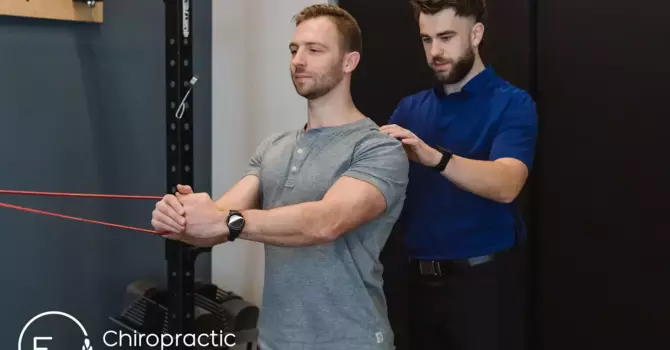
Lifting heavy weights is an essential part of strength training, whether you’re a seasoned athlete or just starting your fitness journey. However, improper technique, lack of preparation, and overuse can lead to joint pain and injuries that may sideline your progress. Protecting your joints while lifting is crucial to maintaining long-term health and mobility. In this guide, we’ll explore effective strategies to keep your joints strong, reduce injury risk, and optimize performance.
Why Joint Health Matters in Strength Training
Joints are the connections between bones that provide stability and facilitate movement. When you lift heavy weights, your joints endure significant stress, especially if proper precautions aren’t taken. Without adequate care, you may experience stiffness, inflammation, and even chronic pain, limiting your ability to exercise effectively.
At E3 Chiropractic + Wellness, we help active individuals in Saskatoon maintain healthy movement patterns, avoid injuries, and achieve their fitness goals. Below are key strategies to keep your joints healthy while lifting heavy.
1. Prioritize Proper Form and Technique
One of the biggest mistakes lifters make is sacrificing proper form for heavier weights. Poor mechanics put undue stress on your joints, increasing the likelihood of injury. Here’s how to maintain proper form:
- Engage Your Core: Activating your core muscles provides stability and helps distribute the load evenly, reducing strain on your joints.
- Keep a Neutral Spine: Avoid excessive arching or rounding of your back during movements like squats and deadlifts. A neutral spine maintains proper alignment, reducing stress on the lower back and knees.
- Use Controlled Movements: Jerky, uncontrolled motions increase joint stress. Lift and lower weights in a smooth, controlled manner to minimize impact.
- Align Your Joints: Ensure that your knees, hips, and shoulders are properly aligned throughout the movement to prevent excess pressure on any single joint.
If you’re unsure about your form, working with a fitness professional or consulting a Saskatoon Chiropractor at E3 Chiropractic + Wellness can help you refine your technique and prevent injuries.
2. Warm Up and Cool Down Effectively
Jumping straight into heavy lifting without a proper warm-up can shock your joints and muscles, increasing the risk of strains and injuries. Here’s what an effective warm-up should include:
- Dynamic Stretches: Movements like leg swings, arm circles, and torso twists help prepare your joints for the range of motion required in lifting.
- Mobility Exercises: Foam rolling and mobility drills target stiff joints and improve flexibility, reducing tension before lifting.
- Light Repetitions: Performing warm-up sets with lighter weights primes your muscles and joints for heavier loads.
After your workout, a proper cool-down helps prevent stiffness and promotes joint recovery. Focus on:
- Gentle Static Stretching: Hold stretches for 20–30 seconds to improve flexibility.
- Foam Rolling: Target sore muscles and joints to reduce post-workout stiffness.
- Hydration and Nutrition: Replenish fluids and consume nutrient-dense foods to support joint recovery.
3. Strengthen Supporting Muscles
Strong muscles help stabilize joints and absorb impact, reducing excessive strain on cartilage and ligaments. Incorporate exercises that target stabilizing muscles, such as:
- Glute Bridges and Hip Thrusts: Strengthening the glutes helps protect the lower back and knees during heavy lifts.
- Rotator Cuff Exercises: Shoulder stability is crucial for pressing movements. Incorporate banded external rotations and face pulls.
- Core Training: Planks, dead bugs, and Pallof presses enhance spinal stability, reducing unnecessary joint stress.
4. Manage Load Progression
Overloading your joints with excessive weight before they’re ready is a recipe for injury. Follow these guidelines for safe progression:
- Increase Weight Gradually: Aim for small, progressive increases rather than large jumps in resistance.
- Listen to Your Body: If you experience joint pain, reduce the load and reassess your technique.
- Use Variations: Swap out high-impact movements for joint-friendly alternatives, such as replacing barbell squats with goblet squats if knee discomfort arises.
5. Optimize Recovery
Proper recovery is just as important as the workout itself. If your joints feel sore and stiff, you may not be allowing enough time for repair. Recovery strategies include:
- Prioritizing Sleep: Quality sleep is essential for muscle and joint recovery. Aim for 7–9 hours per night.
- Hydration: Drinking enough water helps maintain joint lubrication and elasticity.
- Chiropractic Care: Regular chiropractic adjustments at E3 Chiropractic + Wellness can help address movement imbalances, alleviate joint stress, and improve overall mobility.
6. Incorporate Joint-Supporting Nutrition
What you eat plays a vital role in joint health. Consider adding the following nutrients to your diet:
- Omega-3 Fatty Acids: Found in fish, flaxseeds, and walnuts, omega-3s help reduce inflammation and support joint function.
- Collagen and Gelatin: These support cartilage repair and may help reduce joint pain.
- Vitamin D and Calcium: Essential for bone strength and joint integrity.
When to Seek Professional Help
If you experience persistent joint pain despite taking precautions, it may be time to consult a Saskatoon Chiropractor at E3 Chiropractic + Wellness. Chiropractic care can help identify movement dysfunctions, provide targeted treatments, and develop a personalized plan to keep your joints healthy.
Final Thoughts
Protecting your joints while lifting heavy is essential for maintaining long-term strength and mobility. By prioritizing proper form, warming up effectively, strengthening stabilizing muscles, managing load progression, optimizing recovery, and supporting joint health through nutrition, you can lift safely and efficiently.
If you’re looking for professional guidance to improve your lifting mechanics and prevent joint injuries, E3 Chiropractic + Wellness is here to help. Click HERE to book a free discovery call today and take the first step toward healthier movement and pain-free lifting!





